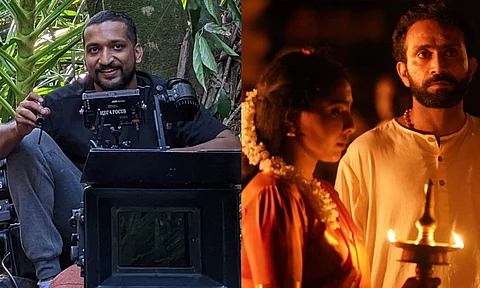

The storytelling quality of Aishwarya Lekshmi's new film Kumari may not have bowled over everyone, but any quibbles about its technical merits are virtually non-existent, most notably the stunning camera work from newcomer Abraham Joseph. An alumnus of Prague's prestigious FAMU film academy, the Thiruvananthapuram native shares what it's like to shoot a horror fantasy under budgetary constraints.
Excerpts:
What visual choices and logistical challenges dictated the final look of Kumari?
Nirmal and I were aware that we were taking on something quite ambitious. To start with, we treated the two lands -- Kumari's and Dhruvan's -- differently. The former with a brown and sunny feel, and a lush green, misty landscape for the latter. We used fog and rain effects to achieve a wintry mood. A tight deadline and limited visual effects budget meant achieving many things on camera. So we planned the set pieces beforehand, scheduled them well, and used storyboards when needed.
The creatures' portions must've been quite a task...
We wanted to create a sustained sense of mystery and make their presence felt before actually revealing the demons. So we put more emphasis on the mood and atmosphere. In the initial parts, we decided to show only a few body parts of one of the demons. The other demon was almost always shown in silhouettes, accompanied by mist. The smoke effects came in handy here, too.
We had a lot of back and forth about whether to show the demons fighting or not. Once we agreed that it would make commercial sense to show the demons in the climax, how to do it was a tricky question. We knew that it shouldn't look like two humans fighting. To work around the limitations, we tried to enhance the mood in the climax using production design, lighting and special effects instead of relying on VFX to bring in supernatural elements.
How would you recall your experience with Shine Tom Chacko and Aishwarya Lekshmi -- two actors with distinct acting styles?
I find Shine's flamboyant acting style quite appealing. He has the psychological spark necessary for characters like Dhruvan. He can find depth even in simple dialogues and he would create background details that made sense for that character and performance.
Shine had his own ideas about how Dhruvan would even move. So, especially in dialogue scenes, we would read them first, collaborate with the actors and then break down the shots. He would give you an idea about how he would do something rather than leave you clueless. I liked that and got a big kick out of this collaboration. He is still part of the process, mind you. It's not like we left him entirely to his own devices. Given his early experience as an assistant director, his cinematic language is sharp. No continuity issues with him because he always remembers where he stopped last. He has a great sense of what he is doing and is willing to give as many takes as needed.
Aishwarya, on the other hand, is a perfect director's actor with immense dramatic range. It is easy to work with her because she would give you exactly what the script specifies. And she also has the ability to vary the emotional details of her performance according to the director's demand. I feel great that she is getting much-deserved pan-Indian attention now for her non-Malayalam films.
The lighting in this film is gorgeous. Aside from available and natural sources, did you guys use artificial light sources to simulate natural light at any point? I ask this because Kumari doesn't have that 'staged' look found in most Indian films of this genre.
We did use additional light sources for support aside from the natural light from the lamps. The period Kumari was set in wasn't one with electricity. The two cameras we used-- RED Gemini for the night and Arri Alexa for the day -- helped us create the specific mood we wanted. Because we now have digital cameras with high sensitivity, we can shoot in low light or create a darker mood without worrying about exposure. The idea was to create an eerie atmosphere with Dhruvan's illam. We wanted to make the land a character of its own, surrounded by mountains and forests, almost as if entrapping its few inhabitants.
As I said earlier, we used relatively vibrant colours in Kumari's land and more blues and darker colours in Dhruvan's. We experimented with colours in a way that goes against the grain. For example, the unlikely blue walls in Dhruvam's illam or the changing colour palette of the characters' costumes as the story progressed. We were initially sceptical of doing something unconventional, but, to our relief, it came out well.